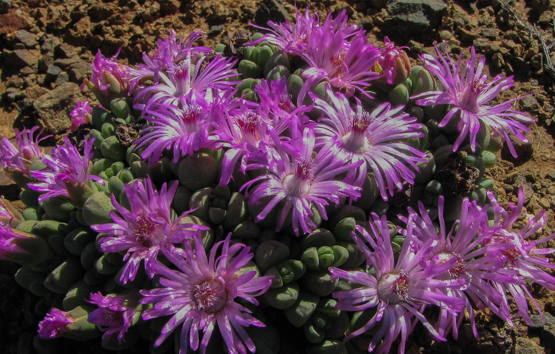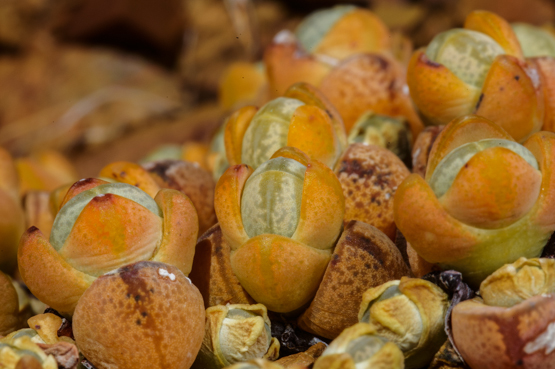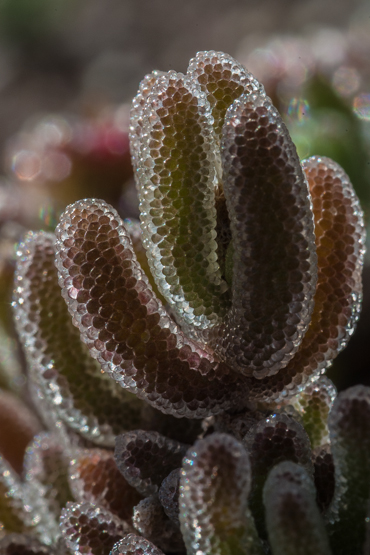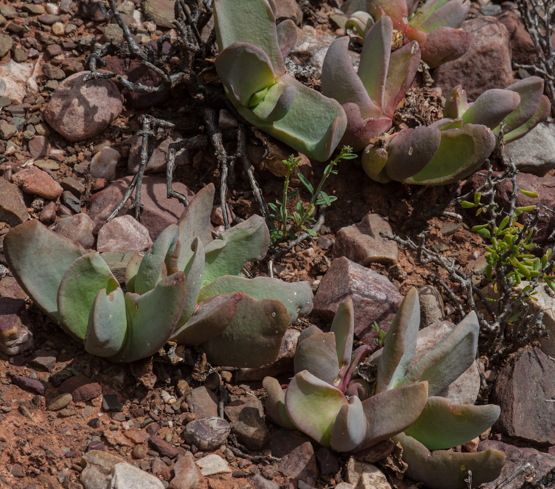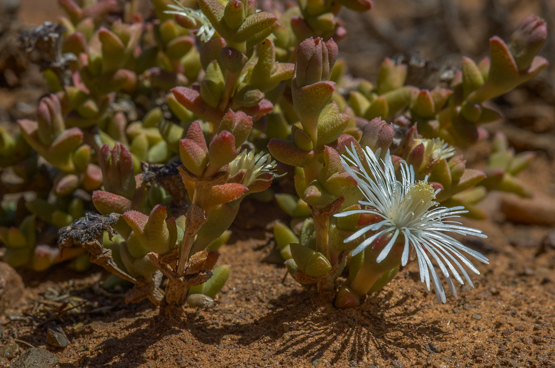Shrubby Mesembs are often difficult to identify with the help of literature. Once a more knowledgeable person has given you the right name, it usually seems hard to believe that you didn’t get there under your own steam.
This species is a case in point. Especially older plants are easily recognized: robust shrubs of up to a meter tall with the old inflorescences remaining on them for several years. These remains are hard and spiny, giving rising to the specific epithet.
R. pungens is a widespread species, occuring from Montagu to the Eastern Cape.
Tag: vygies
Nelia pillansii
Gibbaeum nuciforme 2
Gibbaeum nuciforme (G. cryptopodium) 1
A widely distributed species (from Zebra, between George and Oudtshoorn, to the Montagu area), often locally abundant on loamy soils with quartz pebbles.
The very soft, almost translucent bodies lie flat on the ground (cryptopodium literally means “with hidden foot”) and in dry periods often almost disappear from sight. In the rainy season they are yellowish green, often turning red in the dry period. They are more or less round or egg-shaped (nuciforme = shaped like a nut).
To be continued.
Antimima pumila
Although this species sometimes occurs in big colonies, it is nevertheless rather rare, as a result of the limited distribution area (along the border of the winter rainfall area, more or less in the Ceres-Sutherland-Laingsburg triangle). With leaves about a centimeter long, it really lives up to its name (pumila = dwarf).
The difference in appearance between plants in the resting and the growing period is so great that Louisa Bolus described the species twice within two years (as Ruschia pumila and R. levynsiae).
The pictures shown here will hopefully give you a good idea how much the plants change in a couple of months.
The first picture was made at the end of April (= Autumn) and the last one mid November (end of Spring). The flowering plants were photographed end of July-beginning of August.
Drosanthemum hispidum
From late Winter to early Summer one can find this species in flower in southern Namibia and many parts of South Africa. It is an important pioneer on disturbed soil, e.g. roadsides, forming mats of up to a meter across. For that reason it is also a good ground cover in suitable climates.
The hairy stems make it usually easy to recognize this plant. The beautiful bladder cells on the leaves are best admired in back light.
Octopoma quadrisepalum
Although this species and its sibling O. octojuge (see post 16 June this year) have the same general distribution area (Laingsburg, Ladismith and Swellendam), they never seem to grow together. It is a pity one does not see them in cultivation more often, as both are nice little shrubs (not more than 10 cm tall), with relatively big flowers. The photos were taken northeast of Montagu on the road to Anysberg on 30 October 2013. In the first picture you will also see Gibbaeum nuciforme.
Brownanthus ciliatus ssp. ciliatus
Together with the other members of the genus this is among the few stem succulents in the family. The short-lived leaves are provided at their base with a fringe of long hairs (cilia = lash).
The plants occur from Calvinia in the north to Ceres in the southwest and Willowmore in the southeast, usually as pioneers on dry flats and on roadsides.
The first picture was made in autumn (4 April 2007), the others in winter (early August to early September 2010).
Glottiphyllum linguiforme
Another peculiar name: both glottis and lingua mean tongue, phyllum = leaf and forme = yes, indeed. So, in other words: the tongue leaf with the tongue shape.
The plants occur in the Oudtshoorn-Calitzdorp area, where the rainfall is 100-200 mm per year. They usually grow under shrubs on loamy or sandy soil with some quartzite and flower in late autumn and winter (March-June).
Ruschia nana
Two months ago I found one specimen of an interesting miniature shrub on the road from Montagu to the southwest entrance of Anysberg Nature Reserve (see first picture). After some digging in the literature I found out that it was Ruschia nana (nana = dwarf). The combination of 6 rather than 5 calyx lobes and locules (compartments in the fruit) on the one hand and compact growth on the other, is apparently unusual.
When I had another look at the picture, it occurred to me that I had seen similar plants a few years before on the farm near Matjiesfontein. By road this is quite a distance, but as the crow flies it is not more than about 70 km.
The other two pictures give an impression of these plants (as it happens they were also taken in October). I am sure they belong to the same species.





















